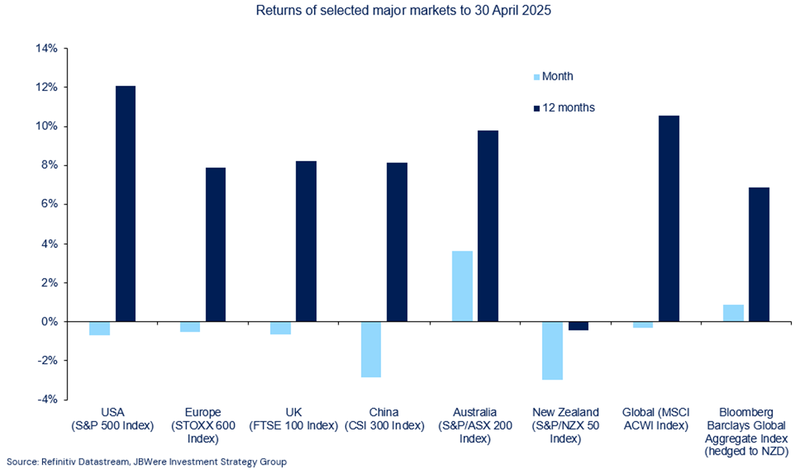Wednesday 13 May 2025
Key takeaways:
- The global share market1 ended April down -0.3% (all returns are in local currency unless otherwise stated).
- Financial markets reacted negatively to the US ‘Liberation Day’ tariff announcement, leading to a sharp four-day market sell-off.
- In response to the US tariff announcement, China promptly imposed higher tariffs on US imports, igniting an escalating trade war between the two nations.
- The decline in share markets was brief, with a strong rebound occurring after the US eased the more aggressive tariffs for most countries (excluding China) to allow time for negotiations.
- Share market volatility decreased by the end of the month, however, uncertainty remains. Volatility is expected to fluctuate in the near-term presenting opportunities for investors.
Below is an in-depth review of financial markets over April.
It was a turbulent month, with the direction of financial markets driven by US tariff announcements. The tariffs, announced at the beginning of the month, were more aggressive than anticipated, with the potential to significantly hamper global trade and growth. Share markets worldwide reacted negatively, with the US share market2 experiencing a decline of over 10% in the two trading days following the announcement.
Other share markets around the world also experienced a sell-off in response to the US tariff announcement, though not quite as severely as in the US. Trump’s tariff policy imposed a universal 10% tariff on all imports into the US (including New Zealand and Australia), while around 60 countries faced higher specific ‘reciprocal’ tariffs. Trump further intensified his tariff agenda by announcing an intention to also target specific industries, such as pharmaceutical companies, which were originally exempt from the first set of reciprocal tariffs.
While other countries took time to evaluate the impact of the new US tariffs, China responded immediately, imposing tariff hikes on US imports. This led to an escalating trade war between the world’s two largest economies. The US tariff rate on most Chinese imports has effectively now reached 145%.
Investors responded to the ‘reciprocal’ US tariffs by selling US investments across the board, with the ‘sell America trade’ extending beyond shares. Yields on 10-year US Treasuries, which did eventually end April lower, rose to 4.5% (bond prices move in the opposite direction to yields). President Trump expressed his desire for the US Federal Reserve (the Fed) to lower interest rates to support the economy, increasing his animosity towards the Fed Chair, Jerome Powell. In response, the Fed stated that the new reciprocal tariffs are likely to raise inflation and lower growth. Indicating it would not adjust interest rates until it had a clearer understanding of the ultimate impacts.
Rising bond yields, increasing corporate discontent and potentially declining popularity led President Trump to temporarily suspend the more aggressive US tariffs on most countries (China being the exception). Trump announced the suspension to allow negotiations, resulting in a strong rebound from the April lows in share markets around the world.
Somewhat overshowed by the tariff announcements, the US earnings season has begun. At the end of April, around two-thirds of companies had reported, with results generally exceeding expectations. Most of the Magnificant-7 have now reported, with Alphabet, Microsoft and Meta all posting strong quarters, positive outlooks, and disciplined capital expenditure. While Amazon and Apple reported solid quarters, they also revealed their vulnerability to trade policy uncertainty.
Outside the US, the European Central Bank reduced interest rates to 2.25%, citing “exceptional uncertainty” and a deteriorating growth outlook due to rising trade tension. Germany revised its growth forecast for the year to zero, with its export orientated economy expected to be significantly impacted by the US tariffs. The European share market3 ended April down 0.5%.
Chinese policymakers announced further stimulus measures to support growth. GDP came in higher than expected, at 5.4%, for the first quarter of 2025. However, this momentum may be challenged by US tariff policies. Chinese policymakers have indicated that additional support will be provided if necessary to counter the effects of external disruptions.
Closer to home, the New Zealand share market4 continued to trend lower, falling -3.0% for the month. Domestic inflation rose at an annual rate of 2.5% in the first quarter of 2025, up from 2.2%, marking the highest level since June last year. The Reserve Bank of New Zealand reduced the Official Cash Rate by 0.25% to 3.5%. Market heavyweight Auckland International Airport saw an 8% decline in April, with delays in the runway upgrade and weak passenger numbers weighing on its share price. In contrast, the Australian share market5 performed strongly, gaining 3.6% over April.
The unexpectedly large tariffs triggered a decline in the US dollar, seeing the New Zealand dollar appreciate over the month.
The differing fortunes of various market indices are illustrated in the chart below.

Note: Returns are in local currency terms.
The outlook
Financial markets have pulled back from their early-month precipice as market weakness (and in some cases dysfunction) played a key part in forcing Trump to blink. Looking through all the noise and following the shock of the ‘Liberation Day’ announcements, the US appears to be pivoting from escalation to de-escalation. This supports our view that Trump is not immune to economic and political constraints, helping to reduce some of the more extreme downside market scenarios.
From here, markets will welcome any news of trade deals to further reinforce the de-escalation trend. However, we suspect the trade headline rollercoaster will continue for a while yet. Ultimately, the key issue for investors is weighing up what de-escalation looks like, and the ultimate landing spot for tariffs versus the economic damage left behind.
We’re comfortable with a view that tariffs will be dialled back from today’s extreme levels. Although we also need to take seriously the US Administration’s intent to reshape the global trade landscape. So higher tariff rates than where they were at the end of 2024 are to be expected. There will be economic costs from this.
There are clearly a wide range of possible outcomes from here, and we should expect volatility to fluctuate. When it has been appropriate, JBWere has been taking advantage of the opportunities presented by this market volatility. Within the MAS Schemes, JBWere have been purchasing or adding to positions in quality Australasian companies at attractive valuations. They also used earlier strength in fixed income markets to build up some cash to provide flexibility to deploy into global equity markets when opportune moments arise. Uncertainty remains high, but MAS will continue to use our active management style to capitalise on opportunities as they arise.
We have useful online tools to help you:
- Our Fund Finder can help you see if you're in the right Fund for your circumstances.
- Our KiwiSaver Retirement Calculator can help you understand if your retirement savings are on track.
- Our MAS Investor Portal can help you manage your investments online.
If you decide to change your Fund after reviewing your risk profile or meeting with a MAS Adviser, you can make a switch via the MAS Investor Portal, or alternatively you can complete an investment strategy change request form. There is no fee for switching. Links to the relevant forms are below.
- MAS KiwiSaver Scheme: KiwiSaver Documents and Forms – MAS
- MAS Retirement Savings Scheme: Retirement Savings Scheme Documents and Forms – MAS
- MAS Investment Funds: Investment Funds Documentations and Forms
You can see weekly updates on fund unit prices and returns on our website.
1 As represented by the MSCI All Country World index.
2 As represented by the S&P 500 index.
3 As represented by the Euro Stoxx 600 Index
4 As represented by the S&P/NZX 50 Index
5 As represented by the S&P/ASX 200 Index
This article is of a general nature and is not a substitute for professional and individually tailored advice. Medical Funds Management Limited, JBWere (NZ) Pty Ltd and Nikko Asset Management New Zealand Limited, their parent companies and associated entities do not guarantee the return of capital or the performance of investment funds. Returns indicated may bear no relation to future performance. The value of investments will fluctuate as the values of underlying assets rise or fall.
MAS is a financial advice provider. Our financial advice disclosure statement is available by visiting mas.co.nz or by calling 0800 800 627.
The Product Disclosure Statement for the MAS KiwiSaver Scheme is available: KiwiSaver – MAS
The Product Disclosure Statement for the MAS Retirement Savings Scheme is available: Retirement Savings Scheme – MAS
The Product Disclosure Statement for the MAS Investment Funds is available: Investment Funds – MAS
Medical Funds Management Limited is the issuer and manager of the Schemes.
